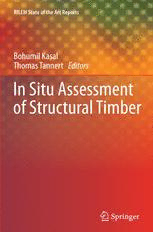
In Situ Assessment of Structural Timber: State of the Art Report of the RILEM Technical Committee 215-AST PDF
Preview In Situ Assessment of Structural Timber: State of the Art Report of the RILEM Technical Committee 215-AST
In Situ Assessment of Structural Timber RILEM STATE OF THE ART REPORTS Volume7 Forothertitlespublishedinthisseries,goto www.springer.com/series/8780 • Bohumil Kasal Thomas Tannert Editors In Situ Assessment of Structural Timber State of the Art Report of the RILEM Technical Committee 215-AST ABC Editors BohumilKasal ThomasTannert FraunhoferInstituteforWoodResearch BerneUniversityofAppliedSciences Wilhelm-Klauditz-InstitutWKI TimberandCompositeConstruction BienroderWeg54E Solothurnstrasse102 38108Braunschweig 2500Biel Germany Switzerland E-mail:[email protected] E-mail:[email protected] ISBN978-94-007-0559-3 e-ISBN978-94-007-0560-9 DOI10.1007/978-94-007-0560-9 SpringerDordrechtHeidelbergLondonNewYork (cid:2)c RILEM2010 Nopartofthisworkmaybereproduced,storedinaretrievalsystem,ortransmitted inanyformorbyanymeans,electronic,mechanical,photocopying,microfilming, recordingorotherwise,withoutwrittenpermissionfromthePublisher,withtheex- ception of any material supplied specifically for the purpose of being entered and executedonacomputersystem,forexclusiveusebythepurchaserofthework. Coverdesign:eStudioCalamarS.L. Printedonacid-freepaper SpringerispartofSpringerScience+BusinessMedia(www.springer.com) Contents State-of-the-ArtReport .......................................... ix Preface ........................................................ xi ListofSymbolsandAbbreviations................................. xiii ListofFigures ..................................................... xv ListofTables ...................................................... xix Introduction.................................................... 1 References..................................................... 3 1 StressWaves ............................................... 5 BohumilKasal,GretchenLear,andThomasTannert 1.1 Background.............................................. 5 1.2 Equipment............................................... 7 1.2.1 Sounding ........................................ 7 1.2.2 SonicStressWaves ................................ 7 1.2.3 UltrasonicTechnique .............................. 10 1.2.4 UltrasonicEchoTechnique ......................... 11 1.3 Application .............................................. 14 1.3.1 DefectandDeteriorationDetection................... 14 1.3.2 MechanicalProperties.............................. 18 1.4 Limitations .............................................. 19 1.4.1 DeteriorationandDecayDetection................... 21 1.4.2 MechanicalPropertyPrediction...................... 21 References..................................................... 22 v vi Contents 2 GroundPenetratingRadar ................................... 25 MehdiSbartaï 2.1 Background.............................................. 25 2.1.1 DielectricPermittivityofWood...................... 27 2.2 Equipment............................................... 29 2.3 Applications ............................................. 32 2.3.1 Detection ........................................ 33 2.3.2 MoistureEvaluation ............................... 34 2.4 Limitations .............................................. 35 References..................................................... 36 3 Radiography ............................................... 39 BohumilKasal,GretchenLearandRonAnthony 3.1 Background.............................................. 39 3.2 Equipment............................................... 40 3.2.1 Technology....................................... 40 3.2.2 GammaRays ..................................... 41 3.2.3 X-Rays .......................................... 41 3.2.4 RadiationAttenuation.............................. 42 3.2.5 Imaging ......................................... 44 3.3 Application .............................................. 47 3.4 Limitations .............................................. 48 References..................................................... 49 4 ResistanceDrilling .......................................... 51 GretchenLear,BohumilKasalandRonAnthony 4.1 Background.............................................. 51 4.2 Equipment............................................... 52 4.3 Application .............................................. 53 4.4 Limitations .............................................. 56 References..................................................... 57 5 Core-Drilling............................................... 59 BohumilKasal 5.1 Background.............................................. 59 5.2 Equipment............................................... 60 5.3 Application .............................................. 61 5.4 Limitations .............................................. 64 References..................................................... 65 6 ShearTestofGlueLines ..................................... 67 ThomasTannert 6.1 Background.............................................. 67 6.2 Equipment............................................... 67 6.3 Application .............................................. 69 6.3.1 DeterminationofPercentageWoodFailure ............ 70 Contents vii 6.4 Limitations .............................................. 70 References..................................................... 72 7 TensionMicro-Specimens .................................... 75 BohumilKasal 7.1 Background.............................................. 75 7.2 Equipment............................................... 76 7.3 Application .............................................. 77 7.4 Limitations .............................................. 78 References..................................................... 80 8 ScrewResistance ........................................... 81 NobuyoshiYamaguchi 8.1 Background.............................................. 81 8.2 Equipment............................................... 82 8.3 Application .............................................. 82 8.3.1 StrengthEstimatefromScrewWithdrawalTest......... 82 8.3.2 Strength Estimate from Screw Withdrawals and VelocityofStressWave ............................ 83 8.3.3 ScrewWithdrawalsandAnglesofEntry .............. 83 8.3.4 ScrewWithdrawalsandCompressionCapacity......... 83 8.3.5 DensitiesfromScrewWithdrawals ................... 84 8.3.6 Stiffness Estimate from Screw Withdrawalsand VelocityofStressWave ............................ 85 8.3.7 Summary ........................................ 85 8.4 Limitations .............................................. 85 References..................................................... 86 9 HardnessTest .............................................. 87 MariapaolaRiggioandMaurizioPiazza 9.1 Background.............................................. 87 9.2 EquipmentandApplication................................. 88 9.2.1 JankaHardnessTest ............................... 89 References..................................................... 96 10 MoistureMeasurement ...................................... 99 BohumilKasalandGretchenLear 10.1 Background.............................................. 99 10.2 Equipment...............................................100 10.2.1 PinMeters .......................................100 10.2.2 Pin-lessMeters ...................................101 10.3 Application ..............................................102 10.4 Limitations ..............................................103 References.....................................................103 viii Contents 11 SpeciesIdentification ........................................ 105 NicolaMacchioni 11.1 Equipment...............................................105 11.1.1 MacroscopicEvaluation............................106 11.1.2 MicroscopicEvaluations ...........................106 11.2 Application ..............................................107 11.3 Limitations ..............................................107 References.....................................................107 12 Dendrochronology .......................................... 109 OliviaPignatelli 12.1 Background..............................................109 12.2 Equipment...............................................110 12.3 Application ..............................................111 12.3.1 WoodSpeciesIdentification.........................111 12.4 Limitations ..............................................112 References.....................................................114 13 ReviewofCodesandStandards ............................... 115 NicolaMacchioni,ClaraBertoliniandThomasTannert 13.1 CodesandStandards ......................................115 13.1.1 InternationalStandards.............................115 13.1.2 NationalStandards ................................116 13.2 DescriptionoftheExistingConditions .......................118 13.2.1 DiagnosisoftheStructuralElements .................118 13.2.2 ObjectivesoftheInspection.........................119 13.2.3 InspectionProcedure...............................119 13.2.4 InspectionReport .................................120 References.....................................................120 KeyWordsIndex...................................................123 State-of-the-Art Report ThisreportispartlybasedontheMSthesisofGretchenLearentitled“Improvingthe AssessmentofInSituTimberMemberswiththeUseofNondestructiveandSemi- DestructiveTestingTechniques”(underthedirectionofBohumilKasal)submitted totheDepartmentofCivilEngineeringofNorthCarolinaStateUniversity,Raleigh, NC,inDecember2005. ContributingTCAST-215membersare:RonaldAnthony,WoodScientist, Fort Collins, USA; Professor Clara Bertolini Cestari, Politecnico di Torino, Italy; Dr. Milos Drdacky, Institute of Theoretical and Applied Mechanics, Prague, Czech Republic; Professor Bohumil Kasal, Penn State University, USA; Dr. Nicola Macchioni, Istituto per la Valorizzazionedel Legno e delle Specie Arboree, Italy; Professor Maurizio Piazza, Università degli Studi di Trento, Italy; Dr. Olivia Pignatelli,Dendrodatas.a.s,Italy;Dr.MariapaolaRiggio,UniversitàdegliStudidi Trento,Italy;Dr.MehdiSbartaï,UniversitéBordeaux,France;Dr.ThomasTannert, Bern University of Applied Sciences, Switzerland; Dr. Nobuyoshi Yamaguchi, BuildingResearchInstitute,Tsukuba,Japan. Dr. Thomas Tannert provided vital help during the final phases of the review. HelpofRonaldAnthonywiththemanuscriptsisgreatlyappreciated. RILEMTC215-AST BohumilKasalandThomasTannert Editors ix Preface Woodisoneofthemostintriguingstructuralmaterialsandtheonlyonethatistruly renewable.Alongwithstone,woodistheoldeststructuralmaterialontheplanetand hasbeenextensivelyusedthroughoutthehumanhistory.Duetoitsaestheticalvalue andpositiveenvironmentalimpact,woodhasexperiencedrenaissanceinconstruc- tion. As a biodegradable, hygroscopic, non-isotropic material, the wood presents specialchallengesforaprofessionalandrequiresthroughknowledgerangingfrom biologytocontinuummechanics. This state-of-the-art report reflects the current knowledge in the area of in situ assessment of the physical and mechanical properties of wood structures. Nondestructive, semi-destructive and destructive methods are described in a sys- tematic mannerwheretechnology,equipmentandlimitationsarediscussed. Some ofthediscussedmethodsareusedinothermaterialssuchasmasonryandconcrete. Most of the methods, however,are specific to wood and special qualificationsare required to understand and apply these methods effectively. Existing methods are constantly improved and new methods are being developed. This report includes methods that are used in practice or have shown significant promise and have a bodyofknowledgethatsupportsstatementsmadeinthisreport. Tocontinuetoimprovetheassessmentofinsitutimbermembers,moreresearch is required to both estimate individual member strengths as well as obtain accur- atequantificationofdeterioration.Afterextensiveresearchofstresswaveinvestig- ative techniques for timber members, the conclusion was drawn that the relation- shipbetweenstresswaveparametersandtimbermechanicalpropertieswasnotde- veloped enough to accurately predict in situ member strength. Published research andassociatedcorrelationvalueswereinconsistentandattimesconflictingdepend- ingontechnique,speciesandstresswaveparametersemployed.Researchopportun- itieslieinfindingamethodofapplyingstresswavetechniquestoinsitumembers andarrivingatreliableestimatesofthemember’sstrength. Improvementofthetensiletechniquecouldalsobeaddressed.Correctingequip- mentdetailsaswellasaddressingsamplesizeforgraininclusionandimprovements tothemethodologyforextractingsamplesalongthegraincouldresultinamorevi- xi
